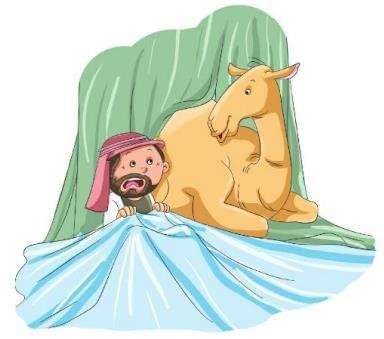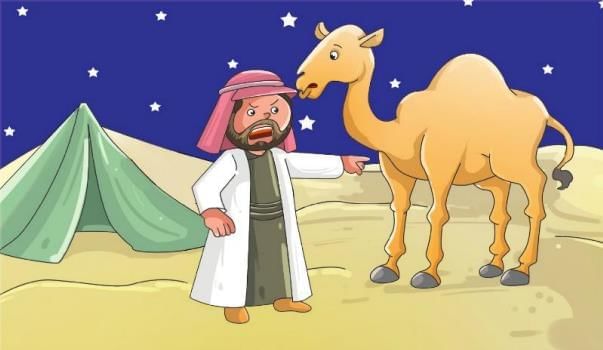The Camel and the Merchant Chapter Notes | English Class 1 ICSE PDF Download
| Table of contents |

|
| Introduction |

|
| Key Points |

|
| Explanation |

|
| Message |

|
Introduction
The chapter "The Camel and the Merchant" is a simple and fun story for Class 1. It is about a merchant and his camel who stay in a desert on a cold night. The camel feels cold and asks the merchant for help. The merchant is kind and lets the camel come inside his tent little by little. But in the end, the camel takes the whole tent! This story teaches us about being kind and careful.
Key Points
This story is about:
- A merchant and his camel stay in a desert on a cold night.
- The camel feels cold and asks to put its head in the merchant's tent.
- The kind merchant allows the camel to put its head, neck, front legs, hump, and body inside the tent step by step.
- The camel grows bold and asks to come fully inside, leaving no space.
- The selfish camel tells the merchant to sleep outside, making the merchant angry.
- The merchant pushes the camel out and sleeps in the tent.
- The camel learns not to be greedy after spending the cold night outside.
Explanation
The story begins with a merchant and his camel resting in a desert during a very cold night. The merchant stays warm in his tent, but the camel shivers outside. Feeling sorry for the camel, the merchant lets it put its head inside the tent. Later, the camel asks to put its neck inside, and the merchant agrees again because of his kindness. As time passes, the camel becomes braver and asks to put its front legs, hump, and then its whole body inside.

Each time, the merchant says yes, even though the tent is small. Soon, there is no room for both of them. The camel, thinking only of itself, tells the merchant to sleep outside. This makes the merchant very upset, and he pushes the camel out of the tent. The merchant then sleeps inside, while the camel stays outside in the cold. After this, the camel decides it will not be greedy anymore.

Message
The story teaches us not to be selfish or take too much. We should be kind and share with others. The camel learns to think about others after being greedy.
New Words with Meanings
- Desert: A dry place with sand and rocks, having very few plants and little water.
- Shivering: Shaking because of cold.
- Peeped in: Looking inside through a small opening.
- Request: Asking for something in a nice way.
- Bold: Doing something without fear.
- Hump: The round, raised part on a camel's back.
- Selfish: Thinking only about yourself and not caring about others.
- Greedy: Wanting more than what you need.
|
38 docs|19 tests
|
FAQs on The Camel and the Merchant Chapter Notes - English Class 1 ICSE
| 1. What role did camels play in trade during historical times? |  |
| 2. How did the merchant class emerge alongside the use of camels in trade? |  |
| 3. What were some of the goods traded via camel caravans? |  |
| 4. How did the geography of certain regions influence camel trade routes? |  |
| 5. What impact did the camel and merchant class have on cultural exchanges? |  |














